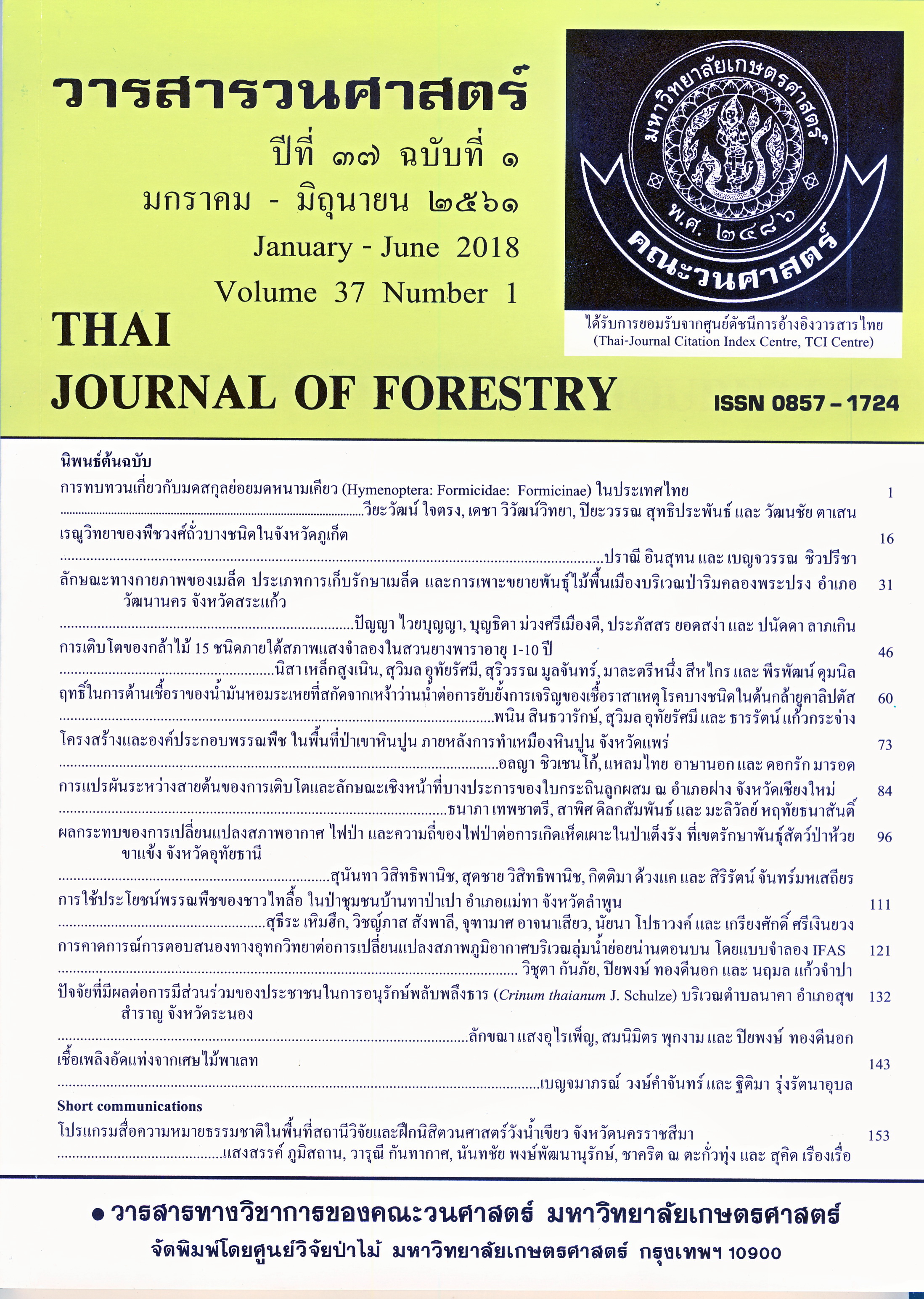ฤทธิ์ในการต้านเชื้อราของน้ำมันหอมระเหยที่สกัดจากเหง้าว่านน้ำ ต่อการยับยั้งการเจริญของเชื้อราสาเหตุโรคบางชนิดในต้นกล้ายูคาลิปตัส
Main Article Content
บทคัดย่อ
ยูคาลิปตัส เป็นไม้เศรษฐกิจที่สำคัญของประเทศไทย แต่ในปัจจุบันกล้ายูคาลิปตัสเกิดความเสียหายจากโรคที่เกิดจากเชื้อราเข้าทำลายอย่างมาก สารเคมีฆ่าเชื้อราจึงถูกนำมาใช้ในการควบคุมและจัดการโรคพืช อย่างไรก็ตามการใช้สารเคมีมีผลต่อผู้ใช้และสิ่งแวดล้อม ดังนั้นการศึกษานี้จึงมีวัตถุประสงค์เพื่อทดสอบประสิทธิภาพของน้ำมันหอมระเหยจากเหง้าว่านน้ำในการยับยั้งเชื้อราสาเหตุโรคของยูคาลิปตัส ซึ่งเชื้อราสาเหตุโรคที่ใช้ทดสอบ ได้แก่ Cylindrocladium reteaudii, Pestalotiopsis sp. และ Sclerotium rolfsii โดยสกัดน้ำมันหอมระเหยจากเหง้าว่านน้ำด้วยวิธีการต้มกลั่น (hydrodistillation) แล้วนำมาทดสอบการยับยั้งเชื้อราด้วยวิธี poisoned food technique ซึ่งใช้น้ำมันหอมระเหยจากเหง้าว่านน้ำที่ระดับความเข้มข้นต่างๆ ดังนี้ 31.25, 62.5, 125, 250, 500, 1,000 และ 2,000 ppm ผลการศึกษาพบว่าน้ำมันหอมระเหยจากเหง้าว่านน้ำสามารถยับยั้งการเจริญของเส้นใยเชื้อรา C. reteaudii, Pestalotiopsis sp. และ S. rolfsii ได้ โดยมีค่า IC50 เท่ากับ 54.76, 126.47 และ 113.68 ppm ตามลำดับ และที่ระดับความเข้มข้น 2,000 ppm สามารถยับยั้งการเติบโตของรา C. reteaudii ได้ 100% ในขณะที่ความเข้มข้น 500 ppm และ 250 ppm สามารถยับยั้งรา Pestalotiopsis sp. และ S. rolfsii ได้ 100% จากผลการศึกษาเห็นได้ว่าน้ำมันหอมระเหยจากเหง้าว่านน้ำมีประสิทธิภาพที่ดีในการยับยั้งเชื้อราสาเหตุโรคของยูคาลิปตัสในสภาพจานเลี้ยงเชื้อ ดังนั้นจึงควรมีการศึกษาเพิ่มเติมโดยเฉพาะอย่างยิ่งการนำไปประยุกต์ใช้ในสภาพเรือนเพาะชำ เพื่อพัฒนาเป็นสารชีวภาพในการใช้ยับยั้งโรคบนกล้ายูคาลิปตัสที่เกิดจากเชื้อราดังกล่าวต่อไป
Downloads
Article Details
ข้าพเจ้าและผู้เขียนร่วม (ถ้ามี) ขอรับรองว่า ต้นฉบับที่เสนอมานี้ยังไม่เคยได้รับการตีพิมพ์และไม่ได้อยู่ในระหว่างกระบวนการพิจารณาตีพิมพ์ลงในวารสารหรือสิ่งตีพิมพ์อื่นใด ข้าพเจ้าและผู้เขียนร่วม (ถ้ามี) ยอมรับหลักเกณฑ์และเงื่อนไขการพิจารณาต้นฉบับ ทั้งยินยอมให้กองบรรณาธิการมีสิทธิ์พิจารณาและตรวจแก้ต้นฉบับได้ตามที่เห็นสมควร พร้อมนี้ขอมอบลิขสิทธิ์ผลงานที่ได้รับการตีพิมพ์ให้แก่วารสารวนศาสตร์ คณะวนศาสตร์ มหาวิทยาลัยเกษตรศาสตร์ กรณีมีการฟ้องร้องเรื่องการละเมิดลิขสิทธิ์เกี่ยวกับภาพ กราฟ ข้อความส่วนใดส่วนหนึ่ง หรือ ข้อคิดเห็นที่ปรากฏในผลงาน ให้เป็นความรับผิดชอบของข้าพเจ้าและผู้เขียนร่วม (ถ้ามี) แต่เพียงฝ่ายเดียว และหากข้าพเจ้าและผู้เขียนร่วม (ถ้ามี) ประสงค์ถอนบทความในระหว่างกระบวนการพิจารณาของทางวารสาร ข้าพเจ้าและผู้เขียนร่วม (ถ้ามี) ยินดีรับผิดชอบค่าใช้จ่ายทั้งหมดที่เกิดขึ้นในกระบวนการพิจารณาบทความนั้น”
เอกสารอ้างอิง
กฤษณา พงษ์พานิช. 2542. โรคของไม้ยูคาลิปตัสในประเทศไทยและแนวทางในการลดผลกระทบ. กลุ่มงานกีฏวิทยาและจุลชีววิทยาป่าไม้ สำนักวิจัยการอนุรักษ์ป่าไม้และพันธุ์พืช กรมอุทยานแห่งชาติ สัตว์ป่า และพันธุ์พืช, กรุงเทพฯ.
ชอุ่ม เปรมัษเฐียร, อภิญญา สุราวุธ, ปิยนันท์ สังขะไพฑูรย์, สุจินต์ แก้วฉีด, นันทิการ์ เสนแก้ว และอาริยา จูดคง. 2549. เทคโนโลยีการผลิตและการใช้สารสกัดจากพืชทดแทนสารเคมี. สำนักงานคณะกรรมการวิจัยแห่งชาติ, กรุงเทพฯ.
พีรศักดิ์ วรสุนทโรสถ, สุนทร ดุริยะประพันธ์, ทักษิณ อาชวาคม, สายันต์ ตันพานิช, ชลธิชา ควรคำนวน, เลิศลักษณ์ พรมใจมา, มณกานต์ จิตคำ และนิลาพร ความดี. 2546. ทรัพยากรพืชในภูมิภาคเอเชียตะวันออกเฉียงใต้ ลำดับที่ 12 (1): พืชสมุนไพรและพืชพิษ. สถาบันวิจัยวิทยาศาสตร์และเทคโนโลยีแห่งประเทศไทย, กรุงเทพฯ. แปลจาก Padua, L.S. de., N. Bunyapraphatsara and R.H.M. Lemmens. 2546. Plant Resources of South-East Asia 12: Medicinal and Poisonous Plants. Veenman printers, Ede., Netherlands.
สุวรรณี แทนธานี, จารวี สุขประเสริฐ, สายจิต ดาวสุโข และโสรญา รอดประเสริฐ. 2557. การศึกษาประสิทธิภาพของสารสกัดว่านน้ำในการยับยั้งเชื้อราก่อโรคผลเน่าที่แยกได้จากผลลิ้นจี่. Bulletin of Applied Sciences 3 (3): 88-101.
Ahlawat, A., M. Katoch, G. Rama and A. Ahuja. 2010. Genetic diversity in Acorus calamus L. as revealed by RAPD markers and its relationship with b-asarone content and ploidy level. Sci Hortic Amsterdam 124: 294-297.
Devi, S.A. and D. Ganjewala. 2009. Antimicrobial activity of Acorus calamus (L.) rhizome and leaf extract. Acta Biologica Szegediensis 53 (1): 45-49.
Gaidhani, S.N., G.S. Lavekar, A.S. Juvekar, S. Sen, S. Arjun and K. Suman. 2009. In-vitro anticancer activity of standard extracts used in ayurveda. Phcog Mag. 5 (20): 425-429.
Ghosh, M. 2006. Antifungal properties of haem peroxidase from Acorus calamus. Ann. Bot. 98: 1145-1153.
Kumar, R., S. Sharma, S. Sharma, A. Kumari, D. Kumar, G. Nadda, Y. Padwad, R.K. Ogra and N. Kumar. 2016. Chemical composition, cytotoxicity and insecticidal activities of Acorus calamus accessions from the western Himalayas. Ind Crops Prod 94: 520-527.
Old, K.M., M.J. Wingfield and Z.Q. Yuan. 2003. A Manual of Diseases of Eucalypts in South-East Asia. Center for International Forestry Research, Jakarta.
Palani, S., S. Raja, R.P. Kumar, P. Parameswaran and B.S. kumar. 2010. Therapeutic efficacy of Acorus calamus on acetaminophen induced nephrotoxicity and oxidative stress in male albino rats. Acta Pharm. 52: 89-100.
Phongpaichit, S., N. Pujenjob, V. Rukachaisirikul and M. Ongsakul. 2005. Antimicrobial activities of the crude methanol extract of Acorus calamus Linn. Songklanakarin J. Sci. Technol 27 (2): 517-523.
Preedy, V.R. 2016. Essential Oils in Food Preservation, Flavor and Safety. Elsevier Science Inc, London.
Raal, A., A. Orav and T. Gretchushnikova. 2016. β-asarone content and essential oil composition of Acorus calamus L. rhizomes from Estonia. J. Essent. Oil Res. 28 (4): 299-304.
Raina, V.K., S.K. Srivastava and K.V. Syamasunder. 2003. Essential oil composition of Acorus calamus L. from the lower region of the Himalayas. Flavour Fragr. J. 18: 18-20.
Sharma, P.K., A.P. Raina and P. Dureja. 2011. Evaluation of the antifungal and phytotoxic effects of various essential oils against Sclerotium rolfsii (Sacc) and Rhizoctonia bataticola (Taub). Arch. Phytopathol. Pflanzenschutz 42 (1): 65-72.
Stegmüller, S., D. Schrenk and A.T. Cartus. In press. Formation and fate of DNA adducts of alpha- and beta-asarone in rat hepatocytes. Food Chem. Toxicol. doi: 10.1016/j.fct.2018.04.025.


